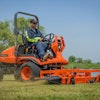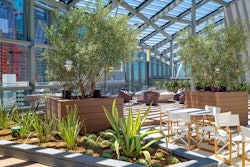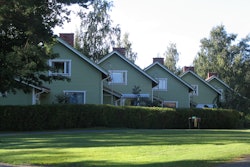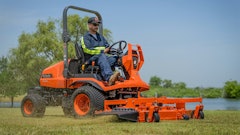Minimizing the effects of construction-related activities on the environment accounts for only 21 out of a possible 250 points under the proposed Sustainable Sites Initiative (SITES) rating system. But don’t let the figure deceive you, say landscape contractors and other professionals familiar with both the SITES Pilot Program and the sustainability movement.
There are many ways to have a positive environmental impact on a project during the construction phase. As Nancy Somerville, executive vice president and CEO of the American Society of Landscape Architects (ASLA) points out, significant elements of construction appear within other SITES rating categories, including how companies protect and restore soil and vegetation, and the choices they make when selecting materials.
“Achieving sustainability can be compared to a three-legged stool,” Somerville says. “Without all three key elements working together—design, construction, maintenance—sustainable goals will not be met.”
Reusing and Recycling Materials
In St. Louis, SWT Design is managing two SITES pilot projects, one at its headquarters and another at a nearby corporate campus. “From the beginning, we have applied every green initiative possible, from sorting out metal and recycling during the demolition phase to installing a green roof, rain garden and permeable parking lot,” relates SWT’s Hunter Beckham, a registered landscape architect.
On the corporate campus, SWT incorporated the re-use of materials in its design.
- On-site rock and aggregate will be used to help establish an aquatic habitat, in addition to being used as base material for an employee walking path.
- Dead or invasive trees along a fence row will be removed, sent to a recycling facility, and eventually reused as mulch on site.
- All soil will stay on site as part of a newly developed interpretive trail and meadow habitat—saving dump truck fuel and helping reduce the project’s carbon footprint.
- Additional solar panels will offset the energy required to power Wi-Fi at a newly constructed garden gazebo, as well as offset the energy consumption of the electric car chargers and security lighting that is going into the new design.
“Twenty-one points out of 250 may not like seem like much, but it can make or break the level of certification you want,” says Beckham. Among other SITES initiatives, SWT designed-in zero water runoff for the corporate campus, employing percolation pits and clean aggregate to facilitate the performance of permeable pavers.
Protecting Vegetation
“It seems that more of our customers want us to preserve existing vegetation,” explains Andrew Key, president of Heads Up Landscaping in Albuquerque, NM. “In a recent Santa Fe park project, for example, we employed significant tree protection with tree barriers, and completely avoided excavation around the canopy. When working at large housing sites, we establish appropriate parking areas ahead of time, and define those areas where heavy equipment will not be used.”
The preservation rules don’t exclusively apply to vegetation either, says Key, a LEED GA (Green Associate). At one recent project, a resident prairie dog was relocated to make way for new construction.
In Albuquerque and other parts of the Southwest, water conservation is a big issue. “We harvest rainwater on many sites,” Key points out. “Cisterns are not new. In fact, their use dates back more than 2,000 years. What is new and exciting is the technology that connects the saved water to an irrigation system.”
In addition to water, vegetation needs the right soil conditions to prosper. Although his company is primarily maintenance-oriented, Pacific Landscape Management president Bob Grover has plenty of opportunity to practice sustainability on large-scale renovation projects.
“We inherit many properties that are environmentally unfriendly,” Grover says. “Soil is often poor and compacted, to the extent that we have to free it of construction debris, add topsoil, and amend with organic material. Good soil allows plants to be more tolerant and forgiving in less than perfect growing conditions.
“We’ve also learned to avoid ‘mudding in’ plant material,” Grover continues. “I recall one site several years ago where a client forced us to install plants in particularly muddy conditions. Five years later, these same plants are still struggling. The challenge with soil prep is that it is virtually invisible to the client and easily value-engineered out of a project.”
Grover’s company encourages clients to take advantage of bioswales and rain gardens to retard water runoff. “These elements need to be designed and installed into the landscape in a way that allows them to be properly maintained,” he emphasizes. “In other words, they need to be integrated into the project, to be maintained just as routinely as the traditional landscape.”
Turning Waste Into Resource
“Waste isn’t waste until it’s wasted,” points out Greg Malone, a LEED GA and director of business processes and logistics for Kurtz Brothers. From its topsoil supplier beginnings in 1948, the Ohio-based company has evolved into recycling.
In 1980, Kurtz Brothers found that spent foundry sand made a great amendment for the state’s heavy, clay soils, and has since recycled more than 7 million tons of the byproduct to be used as soil amendment and aggregate for concrete, among other applications. The company also operates a construction and demolition facility where it sorts and recycles wood waste, bricks and concrete.
“Waste-to-resource is a trend in its infancy,” says Malone, noting that it goes well beyond the use of spent foundry sand. “Landscape contractors can use recycled concrete and stone as aggregates in place of limestone for paver base. Recycled bricks make great decorative mulch around plantings and on pathways, as do pallets that are recycled, ground down and colored. The combination of bio-solids and foundry sand make an ideal topsoil for landscape projects.”
Ohio-based The Pattie Group is a dedicated user of recycled material on its projects. “We design projects up front to re-use as much material as we can,” says president Steve Pattie. “We stockpile reclaimed stone and concrete to be used as driveway base, while excavated soil can be used for mounds and embankments—a better and less expensive alternative than trucking away material.”
The keys for The Pattie Group and its effort to be sustainable designers and builders are planning and getting buy-in from employees. Two company stalwarts, senior landscape architect Josh Tooker and company vice president Frank Bonanno, agree.
“It starts in the beginning, working with the building architect, engineers, builder and owner,” says Tooker. “That’s where decisions are made early on to store and re-use topsoil, to use native plants that are easy to maintain, or to raise the elevation of a pool by a foot or so to save soil and excavation expense.”
Bonanno adds, “Staging and scheduling during construction can be critical. Proper scheduling can reduce the number of needless trips, and having designated staging and parking areas can help reduce soil compaction. How many times have you seen bricks and pavers stacked underneath a tree? It happens, but it’s also unnecessary and can be avoided by a little upfront planning.”
Simple Things Any Landscape Company Can Do
Any size company with almost any experience level can be more sustainable during construction. “Existing trees can be saved by installing fencing around their drip lines,” Pattie points out. “Putting down plywood in heavily trafficked areas can reduce soil compaction. Having separate dumpsters for cardboard, metal, wood and plastic can take the pressure off landfills and save on trucking costs. It can even be partially lucrative. Scrap metal alone brings in close to $200 a month for our company. It’s not a lot, but it adds up.”
Almost every community has a nearby composting facility to accommodate green wastes, along with a recycling center. Make use of them. “We’ve also started using bio-diesel in some of our equipment,” Pattie says. “This fuel is slightly more expensive than regular diesel fuel, but costs will come down.”
Despite the fact that practicing sustainability reduces wasteful consumption of resources and energy, Pattie says it still costs money to be green. “A truly sustainable landscape doesn’t happen without proper planning, the setting up of processes, and actually making the effort,” he emphasizes. “But it’s the right thing to do, and 10 years from now, what takes a little extra time, effort and expense today will absolutely be the expected way of doing business.”





















